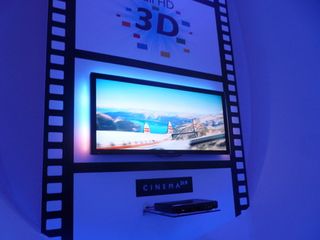LCD vs Plasma: which is the best for 3D TV?
We investigate which is the best 3D TV tech for you

LCD vs Plasma in 3D: the case for LCD
There are certainly many good reasons for Panasonic to say that PDP is a fundamentally better technology for 3D than LCD.
However, plasma is not without its flaws.
Brightness has always been a problem for plasma TVs - the panels struggle to produce sufficient amounts of light while also keeping power consumption down and maintaining a thin chassis.
This is an area where LCD TVs have always excelled. And with recent advances and the introduction of Direct LED LCDs - where an array of LEDs behind the LCD panel illuminate the screen instead of an always-on CCFL lamp - the sheer amount of light produced is a factor which gives LCD something of an advantage when it comes to reducing crosstalk.
Danny Tack, director for technical marketing at Philips, and named the 56th most influential person in Tech in T3's Tech100, believes that it's LCD's ability to produce more light that makes it a better technology for 3D.
The Philips approach
Get daily insight, inspiration and deals in your inbox
Get the hottest deals available in your inbox plus news, reviews, opinion, analysis and more from the TechRadar team.
"Crosstalk is the new thing which you need to keep under control. The way you can keep it under control is by playing with light and some clever processing," says Tack.
"My opinion is that you can have good quality with plasma, but you get better 3D quality from LCD because there is much more light. There are two key facts which we think makes plasma weaker for 3D than LCD.
"For starters, the light that comes out of a plasma is not polarised. It comes out in all directions. In LCD, it's polarised already coming out of the screen. So in LCD you get 500nit polarised light out, and in plasma you get less than 500nit and it's circular light, it has to go through the glasses which are polarised which means with LCD you don't lose light and with plasma you do.
With plasma's glasses you only get half the light through because you only get light from one direction, you lose 50 per cent brightness. That's a fact."
Contouring
Tack also believes that contouring is also a big problem for plasma 3D TVs. Contouring - more commonly referred to as posterisation or solarisation - is a phenomenon seen in older plasma screens where a gradient of colour is not produced accurately enough, resulting in the appearance of ugly colour bands with edges that aren't supposed to be there.
"Yes, plasma has done a great job, year-by-year increasing their sub-fields, went up to 10 and got no contouring. They solved the contouring problem almost completely," Tack says, "but going now to 3D, you have two pictures at once. They claim full resolution per eye, but now actually with the sub-fields you need to divide them over two pictures so you get per picture now only five sub-fields. That is going back in time, we know that when you have less sub-fields, you have contouring. So that is a problem that comes back in plasma."
A sub-field is something a plasma panel uses to pulse illuminated cells repeatedly while each frame is being displayed. A 600Hz sub-field drive is able to pulse each cell/pixel ten times per frame, creating smooth motion.
The scanning backlight
Tack also says that while edge-lit LCD TVs have a comparable amount of crosstalk to plasmas, Direct LED TVs can have much less crosstalk as a result of a scanning backlight. A scanning backlight is able to reduce and increase brightness in parts of the screen to manage the crosstalk problem in realtime.
"I would do the same if I was the Panasonic guys, I'd bring up response time. Indeed we all know that certain colours in PDP have a very fast response, but others have a lot longer so a slower response time.
"For me, the key things when it comes to good 3D is you can reduce it to two elements. It's getting the crosstalk under control, and getting sufficient light. On those two elements, with light, LCD is definitely in the advantage because we can produce much more - we can create a huge amount of light and we can use that advantage over plasma by trading it off. How do you trade it off? By scanning, you lose light by that but scanning definitely will improve your crosstalk because you will not put light where the overlap of right and left pictures are and by doing that you can reduce crosstalk."
Tack admits that Philips' new range of 3D TVs do still have a crosstalk problem, but he says he firmly believes it will be eliminated within a few years.
"Yes, that is true, in the first generation of 3D I agree with you there is in every product a bit of crosstalk. But we can go very fast to no crosstalk. I have seen solutions like the goggles, if you can get the goggles' shutter time higher or you can have better technologies in the goggles, you can use that to eliminate crosstalk. Next year we will make a big step forward. Whether it's going to be zero I don't know but we will do our best."
Current page: LCD vs Plasma in 3D: the case for LCD
Prev Page LCD vs Plasma in 3D: the case for plasma Next Page LCD vs Plasma in 3D: the verdictJames was part of the TechRadar editorial team for eight years up until 2015 and now works in a senior position for TR's parent company Future. An experienced Content Director with a demonstrated history of working in the media production industry. Skilled in Search Engine Optimization (SEO), E-commerce Optimization, Journalism, Digital Marketing, and Social Media. James can do it all.

